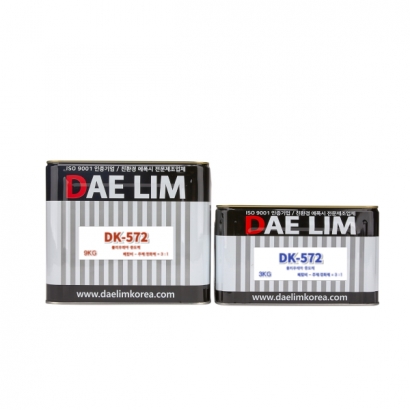
Excellent Adhesion: Improves the bonding strength between the base and topcoat, enhancing the overall coating system\'s performance.
Rapid Curing: Cures within seconds, allowing for fast and efficient application.
Durability: Exceptional impact resistance, water resistance, and chemical resistance, ensuring reliable performance in a variety of environments.
Enhanced Waterproofing: Adds waterproofing properties to the coated surface, providing long-lasting protection.
Ideal for Porous Surfaces: Effectively applied on porous surfaces such as concrete and cement, strengthening the base layer’s durability and performance.
Category | 2nd Intermediate Coat for Polyurea (DK-572) | |
Content | ||
Type | 2-component Polyurea | |
Color | Green, Others | |
Theoretical Coverage | 0.18 Kg/㎡ | |
Dry Film Thickness | 1500μm | |
Drying Time | Touch Dry: within 30 seconds | Initial Cure: within 30 minutes |
Mixing Ratio | Base/Hardener = 3:1 | |
Packaging Unit | 12 kg (Base: 9 kg, Hardener: 3 kg) | |
1. Working Environment
① Do not proceed with construction during or when rain is expected.
② After rainfall, check the moisture content of the substrate (below 8%) before construction. If the substrate is still damp, do not proceed with the application.
③ Do not proceed with construction if the temperature is significantly low (below 5°C), as it may interfere with the application.
④ Be cautious when working in high winds or high temperatures (above 30°C, relative humidity above 85%).
⑤ Ensure proper ventilation and lighting when working in environments with insufficient air circulation or natural light.
⑥ When working on walls, install appropriate scaffolding, and be careful not to damage the applied waterproof layer when dismantling scaffolding.
⑦ Take necessary precautions to prevent contamination from material spillage around the work area.
⑧ Keep the construction site organized and properly maintain equipment and devices near the site.
2. Damage Prevention
When performing tasks on top of the waterproof layer or handling its protection and finishing, be careful not to damage the layer.
① Be cautious when performing tasks that generate sparks, such as welding or grinding.
② Take care during the installation of equipment, piping, and fixtures.
③ Handle, transport, and install or dismantle temporary materials and equipment carefully to avoid damaging the waterproof layer.
3. Construction Method
(1) Surface Preparation
① Ensure the substrate is completely dry (moisture content below 8%).
② Remove any surface irregularities and aging sections with tools like a scraper.
③ Remove rust, oil, dust, sand, grease, paint, and any other contaminants that may affect adhesion.
④ Protect drains from blocking using materials like plastic sheeting.
⑤ If using a one-component product, shake the container before use.
(2) Primer Application (DK-570)
① After surface preparation, apply the primer (DK-570) using a roller, brush, or spray.
② Apply evenly to avoid bubbles or uneven coating.
③ Allow the primer to dry and cure fully to avoid peeling.
(Curing time: Summer 2-4 hours, Winter 5-6 hours)
④ Dilute with up to 10% thinner if necessary.
⑤ For areas with high absorption, apply a second coat of primer.
(3) Repair & Reinforcement (Polyurethane Sealant: DK-510)
① DK-510 Polyurethane Sealant consists of two components, which should be mixed in the correct ratio (Base:Hardener = 1:5).
② For cracks in the surface, fill them with the sealant after applying the primer. For cracks or hollow areas in concrete, cut them into a V-shape and apply the sealant. Apply the mixed sealant evenly to the cracks and joints, smoothing the surface for proper sealing.
③ Allow the applied sealant to cure completely.
(4) Intermediate Coat (Surface Adjustment) Application (DK-571)
① Preparation: Smooth out any surface irregularities or height differences to create a uniform base layer. This is done after the primer and repair work.
② Mixing: Mix DK-571 in the correct proportions. Ensure thorough mixing to avoid bubbles or improper mixing.
③ Application Sequence: Start from vertical walls and proceed to horizontal surfaces.
④ Cure and Check: After the first coat, allow at least 24 hours to check curing before applying a second coat if necessary.
⑤ Application Notes: Avoid applying a thick coat all at once; it’s recommended to apply 2-3 thin coats. Ensure each layer is completely dry before proceeding with the next.
(5) Intermediate Coat (Polyurea Intermediate Coating) Application (DK-572)
① Preparation: Within 1-3 days after the surface adjustment, thoroughly remove any contaminants before starting the coating. Calculate the required amount of base and hardener for the surface area and coating thickness.
② Polyurea Spray Equipment Setup: Set the spray equipment at an appropriate distance of about 60cm with a discharge pressure of 120-150 kgf/cm. Mix the base and hardener in a 1:1 ratio by volume.
③ Mixing and Transfer: The base and hardener are transferred through pumps to the metering pump for mixing.
④ Material Temperature Management: Keep the base and hardener at a temperature above 20°C. If the temperature is low, preheat to reduce viscosity and ensure smooth material transfer.
⑤ Mixing and Application: Heat the mixed materials to 60-70°C and transfer them via a heated hose to the polyurea spray gun for high-pressure mixing and application.
(6) Topcoat Application (DK-573)
① Topcoating is optional and recommended only for exposed areas. It is not necessary for non-exposed areas or waterproofing of tanks and sewage systems.
② After the intermediate coat has cured for more than 1 hour and within 3 days, mix the topcoat base and hardener in the correct weight ratio for application.
③ Mix only the amount that can be used within the pot life, and dilute with T-1021 thinner at a 30% ratio if necessary.
④ Apply the topcoat using a spray or roller.
⑤ For prolonged waterproofing effectiveness, it is recommended to reapply the topcoat every 5 years.